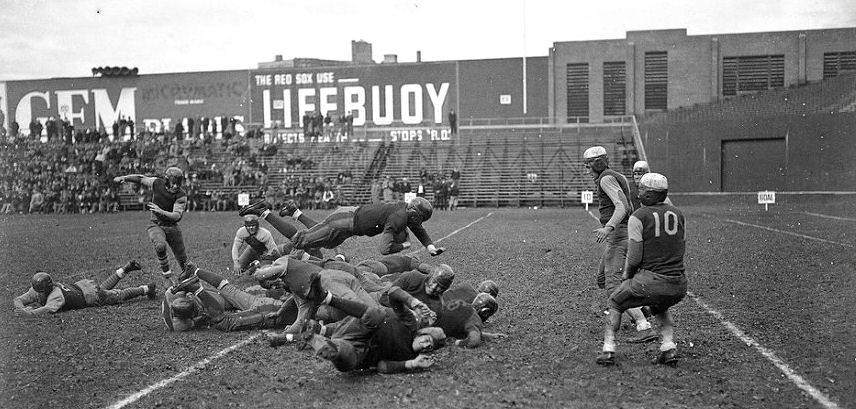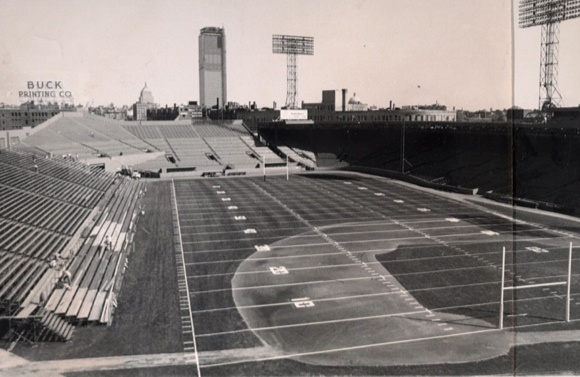Baseball season has ended, hot stove season has begun, and the focus for attention in ballparks across the country has shifted from the field to the front office. The exception: Boston’s Fenway Park.
Friday, November 10th, marks the start of the Fenway Gridiron Series, featuring six scheduled football games at the venerable stadium — three college contests and three high school matchups. Dartmouth and Brown open the series Friday with an Ivy League tilt, followed by Maine and Massachusetts on Saturday. A week from now, Boston College will face Connecticut. The high school showdowns conclude the week, pitting Catholic Memorial against BC High on Tuesday, November 21st, followed by a doubleheader of Masconomet/Everett and Hingham/Scituate on Wednesday, November 22nd. History is strong with the last contest; Hingham and Scituate have met on or near Thanksgiving each year dating back to 1994.
Football at Fenway Park has a far older history, as old as the ballpark itself. In 1912, the year the park first opened, not even a month after the Red Sox captured the World Series against the New York Giants, Boston Latin and English played their Thanksgiving Day rivalry game at Fenway. Two days later, Fenway Park hosted what the Boston Globe called “what many will regard as the National scholastic championship in football,” with Everett High falling to Oak Park (Illinois) High and star Bartlett Macomber, “one of the greatest schoolboy quarterbacks ever seen in this section.” Oak Park’s head coach was future College Football Hall of Famer Bob Zuppke, who unveiled “dazzling trick plays, delayed passes, forward, double, triple and quadruple passes” to flummox the Everett side. Not two weeks later, he was hired to coach the University of Illinois, a position he held through 1941, winning 131 games, seven conference titles and four national championships.
The Boston College Eagles football squad played their first of 76 games (and counting) at Fenway Park in 1915, a cakewalk over Norwich University. Their most famous game on Yawkey Way came 25 years later. Over 40,000 fans attended the November 16th, 1940, showdown between undefeated BC and undefeated Georgetown. Those in attendance included sportswriting icon Grantland Rice, who typed afterward, “It was the greatest all-around exhibition of power, skill, deception and flaming spirit that I have ever seen on a football field for over 40 years” and “probably the greatest football game ever played by college or pros.” Pro Football Hall of Famer Frank Leahy’s Eagles ended the Hoyas’ 23-game unbeaten streak with a heart stopping 19-18 triumph. This summer, Sports on Earth’s Matt Brown ranked the game among the Top 100 college football games ever.
In 1949, another future luminary stopped by Fenway Park for football. Ernie Harwell had been assigned to call the Maryland/Boston University game at Fenway on November 12th, but he was reassigned to North Carolina/Notre Dame at Yankee Stadium when the scheduled broadcaster fell ill. Red Barber, in charge of such matters, quickly contacted a 21-year-old broadcaster whose name had been passed his way, giving him the Maryland/BU assignment. So it was that Vin Scully made his broadcast debut via hand microphone from Fenway Park’s blustery roof, calling Maryland’s 14-13 win over the nationally-ranked Terriers and impressing Barber with his performance against the elements. Scully was rewarded with another football assignment the next week, Harvard vs. Yale, and brought aboard the Brooklyn Dodgers’ broadcast team the ensuing season.
Professional gridiron teams sought unsuccessfully to call Fenway Park home. The Boston Bulldogs in 1926 were the first, playing in Charlie Pyle’s short-lived American Professional Football League. The Bulldogs lasted six games, playing once at Fenway and at Braves Field, and scoring a total of 20 points — 17 of which came in the same game. The NFL’s Boston Redskins welcomed teams to Fenway from 1933-1936, struggled to gain a foothold, and moved to Washington in search of bigger crowds. A second American Football League opened play in 1936, with the Boston Shamrocks winning the AFL’s first title while splitting home games between Braves Field and Fenway Park. A year later, though, the team was a miserable 2-7, players jumped ship, and the league shut down operations.
In the 1940s, the Boston Yanks decided to make a go of it. Coached by Herb Kopf, the Yanks struggled to a 2-8 finish in 1944, their inaugural season. In 1945, they struggled merely to field a full team due to World War II. To solve this problem, they combined rosters with the Brooklyn Tigers, called themselves simply “The Yanks,” and persevered to a 3-6-1 finish. Following three more sub-.500 years, leaving them with a total record of 14-38-3, owner Ted Collins relocated the Yanks to New York.
The most recent professional franchise to play at Fenway Park was the Boston Patriots, who were charter members of the fourth American Football League, moving from Nickerson Field to the larger Fenway Park in 1963. The Patriots proved resourceful when it came to remedying the conversion of a baseball park into a football field. They erected temporary bleachers in front of the Green Monster and placed both teams’ benches side by side in front of the bleachers. As wide receiver Gino Cappelletti recalled, “The two teams had a space between them, but as the game went on, everyone got closer and closer, and you could hear things.”
One of the fans who attended the Patriots’ games at Fenway was future owner Robert Kraft, who credited his experience, “the goosebumps at seeing them come out of the dugout,” with inspiring him to purchase the franchise. Quarterbacked by Babe Parilli, coached by Mike Holovak, and starring future Hall of Famer Nick Buoniconti at middle linebacker, the Patriots reached the AFL Championship in their first season at Fenway Park. (They lost 51-10 to Sid Gillman’s powerhouse San Diego Chargers.)
However, there were clear signs that Fenway could not be the Patriots’ long-term home. Any scheduling conflict with the Red Sox meant that the Pats had to find a field elsewhere. Their ‘home games’ included dates in San Diego and, in the 1968 season opener, Birmingham. 1968 was the Patriots’ final year on Yawkey Way. They played at Boston College in 1969, at Harvard in 1970, and at new Schaefer Stadium in 1971, which gave them a true home facility through 2001.
Football took a hiatus from The Fens. A 47-year hiatus.
On December 20th, 2013, the Boston College Eagles, in concert with the Notre Dame Fighting Irish, announced plans to bring college football back to Fenway Park, the first Eagles’ game at Fenway since 1956. On November 21st, 2015, 38,686 watched the 4th-ranked Fighting Irish hold off the Eagles, 19-16. Back-to-back high school football doubleheaders were held during the following week, and just like that, Fenway Park’s football heritage was reignited. “The success of that [game],” Fenway Sports Management Managing Director Mark Lev told MassLive’s Mark Chiarelli, “allowed us to continue to explore ways to have football, which we hope will be on a fairly regular basis. The timing of it sets up well in November.”
Based on how the 2017 Fenway Gridiron Series fares, there may well be a lot more football in Fenway’s future. It is, after all, what Fenway Park represents: Bringing the past and the present together on the same field, and linking the generations through sports.
This article first appeared in the weekly Football Stadium Digest newsletter. Are you a subscriber? It’s free, and you’ll see features like this before they appear on the Web. Go here to subscribe to the Football Stadium Digest newsletter.



